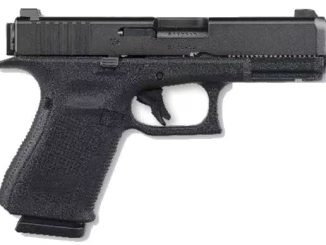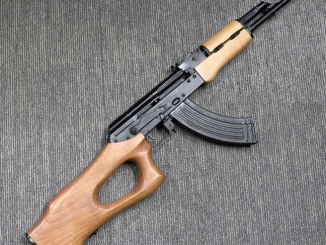The first new breech-loading cartridge rifle adopted by the Austro-Hungarian military was the Model 1867 Werndl, firing the 11x42R black powder cartridge. It used an interesting rotating breech locking system, and replaced the Lorenz muzzleloading muskets and the Wanzl breechloading conversions of Lorenz muskets. The Werndl would also turn out to be the rifle that propelled the Steyr manufacturing company to international prominence, as the Austro-Hungarian purchase of some 600,000 Werndl rifles from them (the factory was owned by Josef Werndl) would be the capital infusion needed to turn it into an industrial powerhouse.
Related Articles

Semiauto pistol
Glock 46: A Revolutionary Design Change
Except for the .22 rimfire Glock 44, all the pistols from the Austrian powerhouse Glock have shared the same fundamental mechanical system. They use the Browning tilting-barrel action, which has been long proven by many […]

Bolt Action Rifles
Vintage Saturday: Colonial
Italy issued a small number of M95 carbine (still in 8x50R) after WWI. Note the Fiat-Revelli M1914 water-cooled machine gun behind him…

Semiauto Rifles
SA-85S: FEG Adapts the Hungarian AK for American Import
Get your copy of “Rifles On The Danube” today – only 2 days left! https://www.kickstarter.com/projects/headstamp/rifles-on-the-danube?ref=3cc2en Hungary began importing semiautomatic civilian versions of FÉG’s AK-63D into the United States in the 1980s. As more restrictions were […]

A few notes about the Werndl.
First, unlike the British with the Snider-Enfield and the Martini-Henry, the Austro-Hungarian Army didn’t fool around with “composite”, i.e. shotgun-type cartridges with metal heads and either paper or metal foil or “coiled brass” cases. Like the U.S., they went directly to the drawn-brass case right from the start. By comparison, when the British got clobbered at Majuba and Isandlwana in 1879 and again got the Army’s nose bloodied at Abu Klea in 1883 during the failed Khartoum relief mission, jamming due to the coiled-brass cases was cited as one of the major reasons. By that time, the U.S. and Austria had been using drawn-brass cases for nearly two decades, but a lot of experts in the UK (notably Greener) were still opposed to them. Mainly I think it was more Parliamentary penny-pinching than anything else.
Second, the Werndl in the original 11.15 x 42R chambering was used by the Ethiopian forces vs. the Italians at the Battle of Adowa in 1896. The Ras Birru House museum in Addis Ababa has one in their collection, displayed right alongside an Italian Vetterli-Vitali 1870/87, two Gras 1874s, and a Carcano 1891 (the latter dated 1901, so too late for the party, as it were). There is also an Austrian Mannlicher Repetiergewher M1895, but it was definitely ex-Italian, captured during the 1935-36 Italian invasion under Il Duce. That’s probably when the Carcano ’91 came in, too. (Men at Arms magazine, Oct. 2015, pp.33-42.)
Next, the unit markings on the buttplate are in standard Austro-Hungarian Army format. 49th Regiment( Infantry, probably), 4th Battalion. The number below the line is the inventory number of the rifle (not the same as a serial number). This is rifle #16,409 out of the 600,000 ordered, so it’s a pretty early example.
Finally, the Werndl breech resurfaced in a rather more imposing context some thirty years later. Namely, in the “Nordenfelt” breech of the French Model 1897 75mm field gun, aka the “French 75” of World War One fame.
Well, I always did suspect that that breech was a little too good of a design to be original with Nordenfelt.
cheers
eon
as it happens the IR49 “Freiherr von Hess” actually was an infantry regiment stationed a bit west of the capital Vienna as seen on this map: https://de.wikipedia.org/wiki/Landstreitkr%C3%A4fte_%C3%96sterreich-Ungarns_1867%E2%80%931914#/media/File:Corps_of_Austria-Hungary.jpg
“Austro-Hungarian Army didn’t fool around with “composite”, i.e. shotgun-type cartridges”
When Russian Empire, starts to use metallic-cartridge rifle (1867), it did not use foil for construction, this cartridge was 15.24x40R Krnka
http://www.municion.org/Krnka/60Krnka.htm
or 6-line in old Russian system, notice that it has more modern style of bullet seating – inside-lubricated (unlike outside-lubricated like in .22 Short). Rifle firing that cartridge was conversion from muzzle-loading (hence quite big caliber) is codenamed “M1867 Russian Krnka” by West collectors.
““French 75” of World War One fame”
In fact, there is even song titled le 75 from that time:
https://www.youtube.com/watch?v=_gNJvuh5URM
maybe some of Français-able of users will translate it for us?
It apparently is pun-intended against Germans who “invented very colossal machines” like Zeppelins and 420 (which probably is meaning Dicke Bertha)
While late balloon head(so called solid balloon head) cases were slightly better than “composite”(british) ones, earlier designs, that is inside primed, folded balloon head and reinforced balloon head, were merely “upgraded” rimfire cases – with most of their drawbacks.
Even reinforced ballon heads were more prone to rim tear/cut than british “composite” cases.
Is there any evidence that the eccentric screw breech of the Mle 1897 was actually inspired by the Werndl breech? After all, many of the falling block rifle breeches are fairly similar to vertically sliding block or wedge breeches commonly used in fixed (cartridge) loading artillery pieces. Fixed artillery rounds are very similar to rifle cartridges, so similar designs are kind of natural and expected.
regarding the unit markings I’ll make a guess and say it was issued to the 49th regiment 4th battalion, which adds up because the 49th was infantry
I have had one of these for 20 years or so. I have always thought a reproduction using this fairly simple action make a good .45LC or Schofield rifle/carbine.
“.45LC or Schofield”
I would suggest .45-70 Government as today available cartridge for that system, which is quite similar in size to later Werndl cartridge – 11x58R (from metric standpoint of view .45-70 Government would be 11x53R). As some era cartridges (1877 vs 1873) so pressure levels should be similar.
Shape of cartridge is of less relevance as mentioned Werndl is non-automatic non-magazine fire-arm.
I am not sure why you want .45 Colt – have you huge stockpile of that cartridges?
Yes, huge stockpile of .45LC and schofield for blackpowder conversions.
Ian, while Werndl carbine and Gasser revolver cartridge were dimensionally same powder load was not.
Austrian M.70 loading for revolvers was 36 grains, also shared with Fruhwirth carbine (hint for one of the next episodes? 🙂 ) while Werndl carbine used 45-48 grains. Difference in volume was filled with ~3mm thick cardboard or felt spacer in revolver ammo. Muzzle velocity was ~230m/s from 7″ barrel and ~250m/s from 9″ barrel.
Firing Werndl carbine ammo in revolver was a sure way to wreck a revolver. Even 36 grain load was hard on revolvers, even reinforced M.1870/74 models, so load was reduced in 1889 to 26-28 grains. Case length was also reduced to 29mm (and spacer omitted) in order to prevent confusion with carbine ammo. As a result muzzle velocity dropped from 230m/s to ~190m/s.
There was also a practice load with ~16 grains powder load and very light (for a caliber), 10g/~153 grains bullet. Empty space in cartridge was filled with two cardboard spacers and sawdust. It produced MV of about 170m/s.
Belgian and French made ammo was loaded with 26-28 grains, most often in 32mm long cases with cardboard spacer.
I have also seen some Montenegrin made ammo loaded with as much as 42 grains of powder, but with lighter bullet (about 18g/277 grains instead of 20g/312 grains).
Is the practice load MV for a revolver? I mean, it’s still more energetic than the original load for the French 11mm Mle 1873 revolver…
Yes, all MVs are for revolver. For practice load IDK if it is from 7 or 9″ barrel however.
It used hollow base lead bullet, a bit similar to the some of the shotgun slugs.
3rd round from the left = target
http://www.oldammo.com/Montenegro2.jpg
There’s an interesting video on the “Cap and Ball” YouTube channel in which the host shoots a Werndl at a target 200m away. https://youtu.be/7_DhmYfAPB0
Josef Werndl denkmal in Steyr
http://weaponsman.com/wp-content/uploads/2016/07/Josef-Werndl-Monument-Steyr-Werndldenkmal-1024×683.jpg
Oh yeah, he was the Boss. I was there last time in 2015 – gorgeous town. Really something to enjoy.
Hallo Ian,
I warnt to add the info that this System is called Tabernacle System in Austria, because of the history, maybe myth, that Werndl had the idea when visiting the catholic mess in his hometown and watching the priest opening and closing that tabernacle which had the form of an vertical drum.